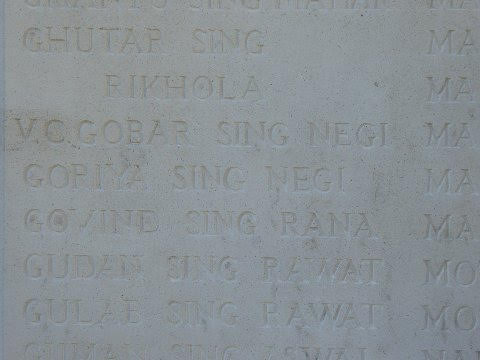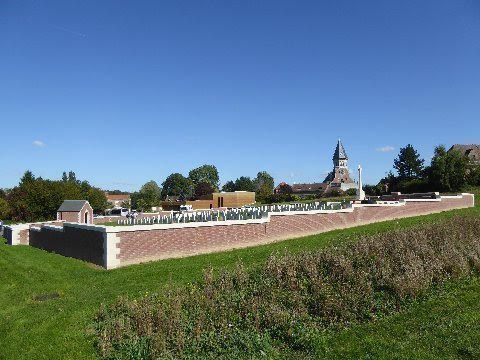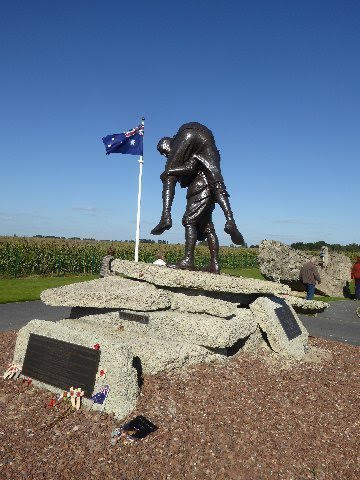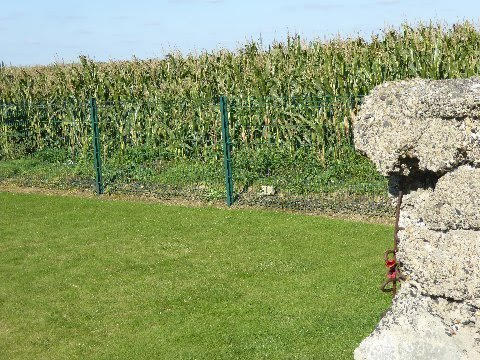Picto Diary - 27 September 2015 - Neuve Chapelle and Fromelles
More or less our WWI battlefield tour follows the path of the British Expeditionary Force (BEF) from the time of their arrival in France in early August of 1914 to the Armistice, 11. November 1918.
The scope of the war is so extensive... the sights of the various battles so numerous... that it is impossible in just over a week to see even a fraction of what there is to see. Like aficionados of America's Civil War, WWI "junkies" seek out obscured trench lines, and study in great detail obscure skirmishes. But, we don't have time to use a fine toothed comb approach to study WWI. In eight days... we can only get an overview... with select detailed stories and explanations interspersed.
To date we have visited Mons, Belgium, and the spot where the first shot was fired by a British cavalryman at Von Kluck's troops advancing through Belgium.
We followed, part way, the August/September 1914 BEF retreat to the Marne seeing Elouge and Le Cateau, sites of significant BEF military engagement early in the war.
We didn't make it to the Marne, the end of the retreat where BEF and French forces stopped Von Kluck's advance. Nor, did we study the British engagements which happened in late 1914 and early 1915 in the "race to the sea."
But, we did join back with the BEF in Ypres, Belgium...where final trench lines of the Western Front had been set on the allied left and the German right after the "race to the sea." The Ypres salient saw, in seven major battles over the course of the war, some of the heaviest of Western Front fighting. In the Ypres salient we learned about the German soldier at a German military cemetery - Langemarck, the German introduction of poison gas in the 2nd Battle of Ypres (later also used by the allies) and underground mining/tunneling operations... Hooge crater.
We moved on to 1915 with our study today of the battle of Neuve Chapelle, the BEF's first engagement after the Western Front lines were set, in Spring 1915. We examined in some detail the Indian soldier's role in WWI through study of the battle of Neuve-Chapelle.
We have occasionally deviated from following the BEF timeline through the war by jumping ahead. For example...
We stopped at Ors, an otherwise unremarkable spot on the Sambre Oise canal, to learn about the British poets and their impact on British perception of the war. At Ors, we focused on Wilford Owen, who was killed on the tow path of the Sambre Oise Canal just one week before the Armistice, in November 1918.
We visited Le Quesnoy where New Zealand troops stormed the ancient city walls to capture 1000 Germans inside in October of 1918.
And today we jumped to July 1916, the time of Somme and Verdun, to look at a short, but bloody battle, Fromelles.

Above: Names on Indian Memorial, Neuve-Chapelle, Pas de Calais, France. 27 September 2015. Note Gobar Sing Negi's Victoria Cross.
Our group visited this memorial this AM. 27 September 2015.
The memorial lists the names of 4742 Indian soldiers with no known grave, who fell in battle while fighting for the British Indian Army in WWI. The memorial is located in Neuve-Chappelle as many Indian soldiers participated in the battle there.
Battlefield guide Patrick Mercer gave us an excellent lecture about Indian soldiers fighting in Europe. They were cold... they came to fight in cotton khakis, suitable for smug subcontinent weather, but wholly inadequate for cold, wet, Europe in Spring. They wore chappals... not boots. They were unused to British trench food... say, pea soup with horse meat.
Still, they fought with distinction.
At the unveiling ceremony for the memorial, in 1927, retired French chief of staff, Marshal Foch spoke:
Return to your homes in the distant, sun-bathed East and proclaim how your countrymen drenched with their blood the cold northern land of France and Flanders, how they delivered it by their ardent spirit from the firm grip of a determined enemy; tell all India that we shall watch over their graves with the devotion due to all our dead. We shall cherish above all the memory of their example. They showed us the way, they made the first steps towards the final victory.
— Marshal Ferdinand Foch, 7 October 1927[4
Indian prime minister, Nirendra Modi, visited the memorial in April, 2015 to lay a wreath. He is quoted:
"I am honoured to pay homage to the Indian soldiers here at the Indian Memorial at Neuve Chappelle. Our soldiers who fought in foreign lands in the Great War, have won the admiration of the world for dedication, loyalty, courage and sacrifice. I salute them."
— Prime Minister Narendra Modi, 11 April 2015[6]

Above: Rudy Jr. stands in field, site within battlefield of Neuve-Chappelle, WWI. Pas de Calais, France. 27 September 2015.
Gobar Sing Negi's VC was earned in the close vicinity to where Rudy Jr. stands in the image.
It is March 2015. Early in the war. The allies have been driven by the Germans to the Marne in September 2014 and have now fought back to establish an 800 kilometer long trench line that extends from Pas de Calais to the Voges. Its time for the allies to test the line... to try for a break through. The Battle of Neuve Chapelle was the first offensive launched by the British in the spring of 1915. The engagement began on 10 March 1915 and ended on 13 March 1915.
The battle began when British forces attempted to break through the German trenches at Neuve-Chapelle and capture the village of Aubers, less than a mile to the east... behind Rudy, Jr. in the above image.
In the opening assault, 342 guns barraged the trenches for 35 minutes, partially directed by reconnaissance planes flying overhead. The total number of shells fired during the barrage exceeded the number fired in the whole of the Boer War (a conflict fought in South Africa between British forces and South African revolutionaries in 1899-1902) - a testament to how much the nature of war had changed in less than fifteen years.
After the opening barrage, British and Indian infantry forces immediately moved in to attack the German trench line along a 4000 yard long front. British/Indian forces succeeded in the center, where the barrage had been effective, but quickly suffered 1000 casualties on the left, where the German trenches had been left undamaged.
Poor communication led to Corps commander Sir Henry Rawlinson, hearing of success in the center, but unaware of slaughter on the left, calling for a further advance. The called for advanced exposed the left flank of the British center and led to further casualties from enfilading German machine gun fire coming from the German right. Reserve troops were not in position to back up British soldiers and heavy losses in the now exposed center were suffered.
Some British soldiers were killed by their own artillery. This points out the problems of early communications in WWI. There was no wireless communication. Telephone wires had to be laid on the ground, and these, of course were susceptible to being broken by artillery and the general chaos of the fighting.
On 13 March 1915, the third and final day of the Battle of Neuve-Chapelle, British/Indian troops repelled a German attack and launched another of their own. They were forced to call a halt after less than two hours, however, as many units had been decimated. By the time the attacks were called off later that day, Allied forces had captured a small salient 2000 yards wide and 1200 yards deep, along with 1200 German prisoners.at the cost of 7000 and 4200 Indian casualties.
Neuve-Chappelle, an early WWI battle, foreshadows the immense and terrible scope of WWI on the Western Front in terms of casualties. In only two weeks, April 1915, the Allies will land on Gallipoli. Through the end of 1915... 8 months, the ANZACs will suffer 8000 casualties in Gallipoli... and the British slightly more. Yet, in only one three day battle of Neuve Chappele, on the Western Front, 11,000 casualties were suffered.
It will get worse.... much worse.
General John Charteris, director of military intelligence under British commander Douglas Haig, took another sobering lesson from the battle, writing that “England will have to accustom herself to far greater losses than those of Neuve Chapelle before we finally crush the German army.”
The above diary entry was posted by me on Facebook some three days ago. Chita's three comments responding to that diary entry via Facebook are germane (and appreciated).
Chittaranjan Gauba Neuve-Chapelle was especially significant because it showed that if done differently, assaults against trenches could succeed. It required a combination of artillery barrages and surprise to support attacking infantry. By learning this, Haig was far more successful than his predecessor, Sir John French. He could, of course, have learned more; Churchill had to point out that tanks were better at withstanding enemy bullets than "the breasts of brave men". It was not until Cambrai (1918) that tanks were used the way they should have been. Although Haig was popularly considered a hero for "winning the war", to many he still represents an outmoded and wrong-thinking class of commander who paid too heavily with the blood of others for successes which were too limited for the cost.
Chittaranjan Gauba John Charteris is a case in point. He had no formal training in or experience with intelligence, and (admittedly with the benefit of hindsight) his analysis and his strategic recommendations were largely over-optimistic. And he certainly was of the school which believed that high casualties were not only inevitable but necessary. Haig liked him, though, and kept him on for too long, despite a great deal of criticism of style and effectiveness.
Chittaranjan Gauba Oh, and just two corrections to note: it's of course Douglas Haig, not Alexander (that's the name of the U.S. general who was White House Chief of Staff during Watergate). Also, the name of the brave Victoria Cross winner from India who died fighting in this battle is correctly spelled Gabbar Singh Negi; both the citation and the memorial have it spelled wrong. BTW: Negi's old regiment, the Garhwal Rifles, "adopted" an annual spring fair named after Negi, held in the town of Chamba every year around his birthday (April 20). The regiment recruits every year at that fair, over one hundred years after his death. Negi was 19 years old when he earned his VC.

Above: Battlefield guide Patrick Mercer explains Battle of Neuve Chapelle fighting. Neuve Chapelle, France. 27 September 2015.
Original gunfire damage could be seen, close up, on original houses at right.
Our battlefield guide, Oxford educated, Patrick Mercer, OBE, served in the British Army for 25 years. He was a brigade commander in Northern Ireland and retired as a full Colonel. He has written ten books on military history and one of his favorite topics, Arthur Conan Doyle's Sherlock Holmes side kick, Dr. Watson.
Patrick's knowledge of his subject matter is prodigious. He is well prepared with an agenda each morning and shows sensitivity and flexibility for tour goer desires. We start off each day with a discussion of the strategic situation, move to the tactics of the particular, battle we are studying, and then, reduce further to a particular battle incident discussing actions and personalities of those involved. Patrick is as comfortable and apt discussing the ins and outs of the British War Council as he is pointing out the individual exploits of a VC winning soldier.
Patrick conveyed to us a number of war anecdotes that added texture to our understanding of the WWI. For example, he told us about how salt influenced the outcome of the war. In the early stages of the war, British artillery ammo was unreliable. The problem was identified as too much salt in the chips served in the 24 hour bars outside of the British ammo factories. Workers, on lunch break, or after hours, would frequent the bars. Eating with an abundance of salt led them to drink a lot. When they worked inebriated the quality control of the ammo suffered. War authorities reduced the amount of salt in the chips which led to less drinking, less inebriation, and an improvement in ammo quality.

Above: Flowers at a residence. Neuve Chapelle, France. 27 September 2015.

Above: 1% stands in Neuve Chapelle Church. Neuve Chapelle, France. 27 September 2015.
War damage could be observed on the exterior of the church.

Above: WWI German bunker. Neuve Chapelle, France. 27 September 2015.
Battlefield guide, Patrick Mercer explains bunker operations. Rudy Jr. and Portland look on.
Several pieces of loose war debris were found at this infrequently visited spot.
It seems amazing that war debris can still be found in spots such as this 100 years after the battles.

Above: Pheasant Woods, Australian WWI Military Cemetery, Fromelles, France. 27 August 2015.
The Battle of Fromelles, 19-20 July 1916, was a brief but bloody Western Front episode of WWI. Its purposes was to take pressure off the French and British in the Battle of the Somme, the iconic, major offensive started on 02 July 1916 some 50 miles to the south.
The fighting at Fromelles lasted twenty-four hours and resulted in a significant reverse for the British and the Australians, the latter seeing action on French soil for the first time. No new ground was gained as the battle was called off due to heavy casualties.
The great war on the Western Front was founded on heavy artillery and machine-guns and the figures from Fromelles show just how brutal it had become. The Australians suffered 5,500 casualties (2000 killed or missing and 3,500 wounded or taken prisoner), the British had 1,500 soldiers put out of action, and the German toll was 1,500 dead or wounded.
It is sobering to realize that the Australians, at Fromelles, lost in one 24 hour period, one quarter of the troops dead as during the entire eight month campaign in the (at least for Australians) Gallipoli engagements, 1915.

Above: Simon Fraser's statue at Memorial Park. Fromelles, France. 27 September 2015.
In the next three days after the battle of Fromelles, despite no official truce being proclaimed, Australian soldiers went out into no man's land to assist their wounded comrades. Their gesture is remembered in the statue, seen in the image, which stands at the center of the park. The statue was unveiled in July 1998 and dedicated to the "cobbers" of the Great War. A replica of Peter Corlett's statue can be seen in the gardens of Melbourne's Shrine of Remembrance.
Born in 1887, Simon Fraser was farming in Victoria when the war broke out. In 1915 he joined the 57th Battalion of the Australian Imperial Force. He fought at the Battle of Fromelles. His diary describes how, on the following day, he ventured out on to the battlefield to help the wounded. His bravery was the inspiration for the pictured sculpture. On 11 May 1917, during the Second Battle of Bullecourt, Sergeant Fraser was reported missing in action. His name is engraved on the Australian National Memorial of Villers-Bretonneux in the Somme.

Above: Fromelles Military Park. Fromelles, France. 27 Setember 2015.
Shot is of German bunker inside the military park. Many of the military parks and cemeteries we saw were bordered by corn fields. Not, also, the poppy decoration affixed to the side of the bunker.
Addendum:

Above: Karen and I stayed with a friend in Soignies-Casteau near Mons in 2011. He was stationed with NATO. Photo's are of a
monument relative to WW I and our host's house.
Spook,
Reston, VA
Steve,
When I read your blog about the Hooge Crater, it reminded me of the
Battle of the Crater from the American Civil War. You may find the
following article interesting:
https://en.wikipedia.org/wiki/Battle_of_the_Crater#Mine_construction
Take care & travel safely! Thanks for including me in your mailing list!
Art,
Dallas, TX
Steve,
You really get around! Appreciate reading about your experiences. Thanks.
Claude,
Redding, PA
Steve,
As usual, a great commentary.
WWI was an insane war that never should have happened, and it birthed WWII. So many young men died for appearances and protocol because a Duke and his wife were killed.
Basketball,
Pelham, NY
thanks Steve. i am trying to catch up with your around the world in 80 days :) do not sit in that lotus even if you could--you will have to be cut out of it .
Brand,
Venice, CA